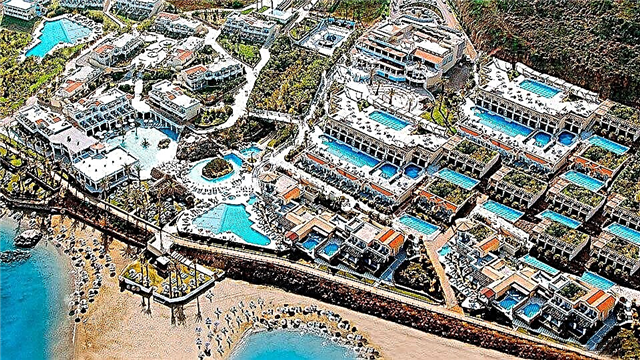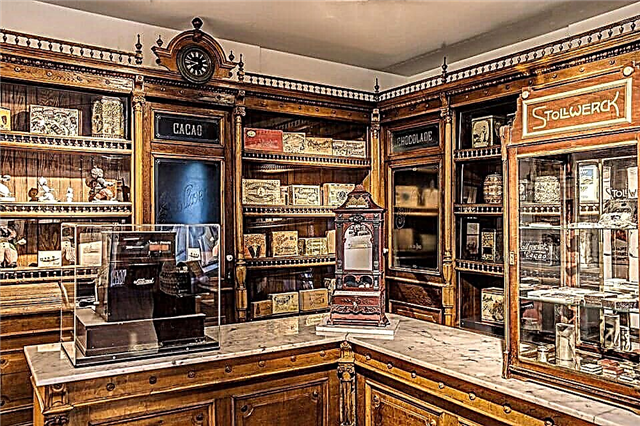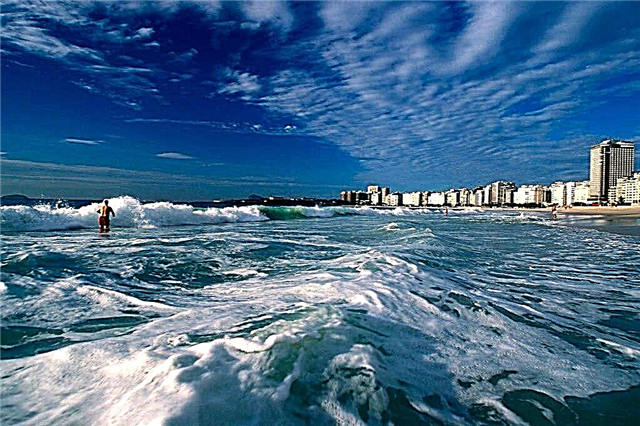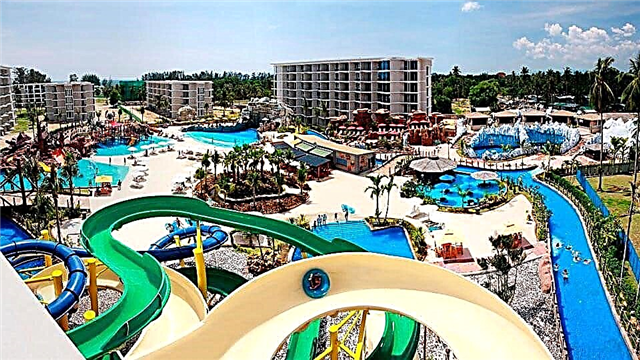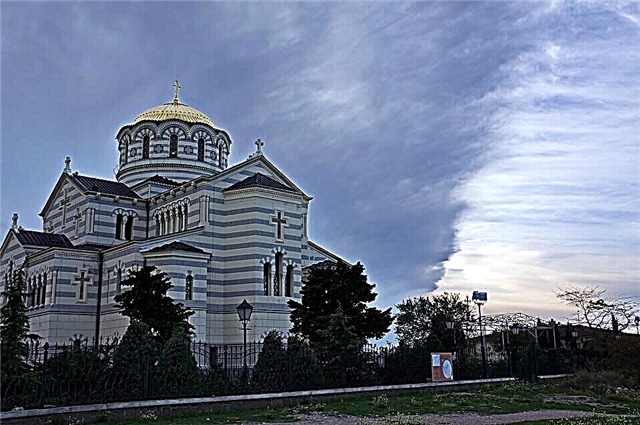Covered with heroic glory, the main southern port, the legendary outpost of Russia embodies the history of the formation of the Black Sea Fleet, its combat battles and victories. The city faithfully preserves the memory of the glorious past of its ancestors, restores monuments, bit by bit collects historical relics and rarities. New museums of Sevastopol are opening and old institutions are developing so that descendants can clearly see and feel the greatness of the exploits of their fellow countrymen.
Panorama "Defense of Sevastopol 1854-1855."

The top of the Bastion Hill of the city is crowned by a beautiful semicircular building, decorated with sculptural busts in the wall niches. This is one of the most popular tourist sites - Panorama of the Defense and Liberation of Sevastopol. The exposition of the 1st floor is devoted to the history of the creation of the Panorama, dedicated to the feat of the Sevastopol people who took part in the defense of the city in 1854-55. Visitors will learn the impressive history of the painting by Franz Roubaud and his subsequent rescue.
The showcases, designed as the side cladding of the ship, display object exhibits: portraits of the heroes of the Crimean War, their personal belongings, weapons, documents. 2nd floor - Panorama itself, exhibited for viewing from the observation deck imitating the Malakhov Kurgan. The 114 m long, 14 m high canvas demonstrates a full-scale defense battle. It depicts various plot scenes, figuratively illustrating dramatic events and their participants.
All stages of defense are reflected throughout the day, from dawn to dusk. Visitors feel themselves involved in the events depicted. They see the famous surgeon Pirogov, the legendary sailors Koshka and Zaika, General Khrulev and others - more than 4 thousand people in total.
Memorial complex Sapun Gora

A natural barrier for enemies, the protective barrier of Sevastopol - Sapun Mountain, towering over the Balaklava Valley, during the wars became the arena of fierce battles. It is quite natural that it was here that the Memorial Complex in memory of the soldiers-liberators was located. Its goal is to reconstruct heroic events unforgettable for history. The central object of the Memorial is the Diorama "Storming Sapun Mountain on May 7, 1944".
In a round building with a balcony around the entire perimeter, the events of that heroic day of liberation from the invaders are captured. One part of the diorama is a huge canvas depicting an assault battle, striking the imagination with the truth of what is happening. Stones covered with ash and drenched in blood, smokescreen, burning weapons, figures of defenders impress to the depths of my soul. The second part of the diorama is a living set made up of genuine exhibits.
They visually complement the painted picture, creating the effect of 4D space. Here, no one remains an indifferent spectator, everyone feels their involvement in these events. In addition to the diorama, a 28-meter obelisk to the fallen soldiers was erected on Sapun Mountain. The names of the victims, the names of units and formations, the names of 240 Heroes of the USSR are engraved on its granite slabs.
The complex includes an open exhibition of military equipment and weapons of the Second World War period. Cannons, howitzers, mortars, including captured German artillery. In May 1995, a chapel-chapel of St. George, there is a monument to the soldiers of the 51st Army. The complex is surrounded by a beautiful park.
House-Museum of the Sevastopol underground

Organized in 1967, the institution is designed to perpetuate the memory of the members of the urban underground who contributed to the fight against the invaders. It is located on the Korabelnaya side, located in a former residential building (early 19th century). The entrance is decorated with 2 pilasters with lower flutes and a 3-cornered attic.
Part of the exposition reflects the authentic atmosphere of those years, with household items and furniture. All this belonged to the leader of the underground, V. D. Revyakin, who lived in the house during the years of the occupation. Here was the headquarters of the underground workers, there was a printing house that printed the newspaper "For the Motherland" and information and agitation leaflets. Instances of some of them are presented as exhibits. Among the exhibits there are photographs, letters, oaths of members of the underground.
A radio receiver, seals, stamps are on display. In the basement where the printing house worked, a typesetting newspaper font, a typewriter, and examples of weapons are exhibited. An exhibition exposition "Strada Partisan" is open in the courtyard. Excursions, meetings and lectures organized.
Malakhov Kurgan

The sacred place - Malakhov Kurgan - is another strategic skyscraper, on which fierce defensive battles took place. The mound named after the Russian officer is located on the Korabelnaya side. Today there is a memorial complex dedicated to the defenders of 2 defenses. The central entrance to the Memorial is crowned with a propylian gate, to which a wide staircase leads. A plate with a mournful inscription was installed at the site of the fatal wound of Admiral Nakhimov.
The majestic monument to Vice Admiral Kornilov is impressive. Next to the monument on a granite slab, a cross made of the cladding of enemy bombs marks the place where the admiral was wounded. If you go up the hill from the street. Istomin, you will come to the Defensive Tower of the Kornilov Bastion. The building of Inkerman stone was erected in the middle of the 19th century as a protective object.
Despite numerous shelling, the tower was almost completely preserved and became a symbol of the resilience and immortality of the Kornilov sailors. The exposition acquaints visitors with the events of the Crimean and Great Patriotic Wars. Courageous defenders of the city appear before our eyes: their names, photos, things, documents. A row of ancient cannons from the 19th century are installed next to the tower. and Soviet armored towers.
Military History Museum of the Black Sea Fleet
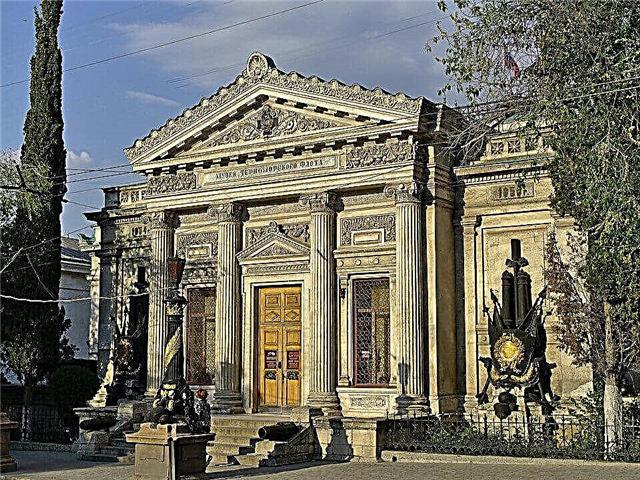
The oldest cultural and historical institution, the Black Sea Fleet, was opened in 1869 in the house of the military engineer Totleben. Nowadays, an important institution for the city is housed in a magnificent building, built in 1895. The beautiful facade with columns is an attraction in itself, and taking into account its internal content, a double attraction. It contains a lot of materials that convey the history of the formation of the Black Sea Fleet and its main base - Sevastopol.
On the 1st floor, you can get acquainted with the biographies of famous admirals, their belongings, awards, portraits. Unique exhibits are surgical instruments of the operating doctor Pirogov, who made a significant contribution to saving lives. There are paintings by Aivazovsky and Roubaud depicting battle scenes. The 2nd floor is dedicated to the heroic defense of the Second World War. Numerous exhibits from the battlefield, naval uniforms, weapons, shells, documents clearly demonstrate the scale of bloody battles.
St. Vladimir's Cathedral

The Sevastopol shrine, an object of veneration and worship of the townspeople - the Vladimir Cathedral was erected in the 19th century as a symbol of the memory of the baptism of Prince Vladimir. The construction of the historical and architectural monument has been going on for more than 30 years. Over time, the temple united a religious institution and the tomb of admirals and officers of the Black Sea Fleet.
Thirty-three years into oblivion (1932-65), the cathedral was restored and handed over to the Defense Museum. In 1991, at the initiative of the Orthodox community of the Black Sea Fleet officers, the upper part of the church was consecrated for church services. In the lower section of the majestic building, there is a tomb with the ashes of 13 admirals. In honor of Istomin, Kornilov, Nakhimov, Lazarev, diorite slabs are installed below with their names indicated.
In the upper section of the cathedral there are marble slabs with the names of 72 naval officers - participants in the Crimean War engraved on them.Every year, memorial services are held in the sanctuary for the sailors of the Black Sea Fleet who died at different times. Here funeral services are held for the submariners of the Kursk, for the crew members of the Varyag, the gunboat Koreets, and others. The atmosphere of light sadness and grief, high spirituality of the Vladimir Cathedral is impressive to the core.
Museum complex "35th coastal battery"

No one remains indifferent when visiting the artillery fortification, which became a museum complex in peacetime. Here was the last line of defense of the city at the beginning of July 1942. Getting on the armored coastal battery No. 35, you are visibly transported into the atmosphere of fierce battles. It is not difficult to assess the scale of human losses, peering into the stone walls of a powerful structure riddled with fragments.
The Pantheon of Memory is shaking, with the carved names of all the defenders of the 35th battery installed at this moment. The casemates recreate the atmosphere of those days, exhibits are presented that illustrate the detailed history of the battery. A spiral staircase leads down, where strategic control objects were located at a depth of 25 m. An observation deck with stunning views has been built on the reserve exit today. A spiral staircase also leads up to the Pantheon of Memory.
Under the dome of the Pantheon, heartbreaking scenes of the battle of soldiers doomed to death are broadcast. From this sight goosebumps and tears in the eyes, the realization of the terrible cost of Victory. It is impossible to leave the Necropolis of the Fallen without excitement, to see the monument to the perished personnel of the 2nd armored tower. The 35th Battery Complex is a great historical and cultural heritage that continues to improve and develop.
Art Museum named after Kroshitsky

Crimean landscapes at all times have inspired the masters of the brush for creativity, so the opening of the Art Museum is quite natural. Many true connoisseurs of painting live here, on whose initiative in 1927 an exhibition of paintings was organized in the house - an architectural monument of the 19th century.
Today his collection is one of the richest and most interesting. More than 10 thousand artistic masterpieces are stored in the funds and are exhibited at permanent and temporary exhibitions. The art gallery is named after the Crimean artist who saved the collection of paintings during the war. Fans of artistic creativity here can see unique paintings of the Italian Renaissance: paintings by Titian, Verrocchio, Giordano, Bassano.
The works of French, German, Dutch, Flemish painters are presented to delight their admirers. The undoubted masterpieces of the great Russian artists take pride of place at exhibitions. The works of Aivazovsky, Tropinin, Repin, Bogaevsky, Korovin are regularly shown to the general public. The institution has a lecture hall and a cinema, where film shows and lectures are held.
Sevastopol Museum of Local Lore

Visitors will find an interesting immersion in the history of the city, in its past and present. He was named after the first director of the institution, Aries E. N., who stood at the origins of its formation. A rich collection of local lore has been collected for 40 years by local lore schoolchildren under the guidance of Aries. Out of more than 20 thousand exhibits, 2,932 copies are displayed in permanent exhibitions.
The institution cooperates with the staff of the Institute of Biology of the Southern Seas, with the reserves "Tavricheskiy Chersonesos" and Karadag and other institutions. The exhibition "Inanimate Nature", which introduces the geological and relief features of the Crimea, mineral reserves and rocks, is of great interest. Many pleasant surprises await everyone in the halls of "Living Nature" with magnificently decorated dioramas "Mountain Crimea", "Okolovodny landscape", etc.
All the diversity of the Crimean flora and fauna is represented: stuffed roe deer, deer, mouflon, griffon vulture, etc. Among them are the Red Data Book specimens of animals, insects, shrubs and trees. It has become a tradition to hold an Open Day on September 1.
Museum of Fortifications

The rich history of the coastal fortifications of the peninsula is embodied in the expositions of 2 large institutions: the Balaklava underground complex and the Mikhailovskaya battery. The first object, located on the Tavricheskaya Embankment, is the southern exposition site of the Military History Museum. An entire underground city, reminiscent of the scenes of science fiction films, opens up before your eyes.
The whole power of military training of the USSR during the Cold War is demonstrated. There are 3 secret military facilities here: a shipping channel for submarines, a production bay, a nuclear arsenal. A Yak-38 aircraft, samples of shells and mines are installed on the site in front of the entrance (Arsenal yard). Inspection of the internal expositions amazes the imagination with the scale of the work and the amount of underwater weapons.
Mikhailovskaya Battery - the northern part of the fortification museum, located in the Nakhimov district. In 19 halls there are more than 5 thousand exhibits illustrating the defense industry of Sevastopol in the entire history of the city's development. The main emphasis is placed on the Crimean War, represented by a huge number of items of military equipment and equipment.
The arrangement of the showrooms in a strict thematic-chronological sequence allows visitors to "travel in time", as it were. They get acquainted with the defense potential of the city, from its foundation (1783) to participation in the victory of the Great Patriotic War (1944) Photos of soldiers, documents, personal belongings of officers and the sailors have immortalized their memory.
Balaklava History Museum

Although almost 2 centuries have passed since the Russian-Turkish war of 1853-55, but the bloody events continue to excite the residents of Sevastopol. One of them is Sergei Gontar, who founded a museum dedicated to the history of Balaklava (2012). Its goal is to learn as much as possible about the participants in the Crimean War, to reveal all the details of the battles.
The opening of the museum was preceded by the organization and holding (2006-12) of military-historical festivals-reconstruction "Alminskie heights" and "Camp near Balaklava". 10 events were held in alliance with the International Military History Association. The staff of the institution is actively searching for abandoned mass graves, establishing the names of unknown soldiers. On the field of the Alma battle in 2019, a monument was erected to the first Russian sister of mercy, Daria Sevastopolskaya.
Grandiose restoration work is being carried out at the old cemeteries (Sonnoye and Gorchakovskoye), where the officers who participated in the Chernorechensky battle who died after being wounded are buried. There are many authentic items among the exhibits. The new exhibition "Heroes with Heroes on You" aroused great interest of visitors.
Museum-reserve of Tauric Chersonesos
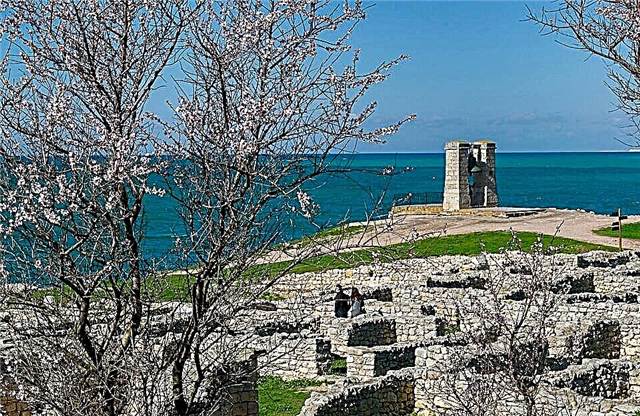
The lively atmosphere of Ancient Greece is felt by those who visit the Tauric Chersonesos, a reserved place on the Crimean coast. Cradle of Christianity on the peninsula, the ancient city was founded by the Greeks in the 5th century BC. Here Prince Vladimir was baptized into Orthodoxy, therefore Chersonesos is a sacred object for Christians. After the devastating destruction of the Golden Horde at the end of 14, the beautiful city ceased to exist.
Judging by the cellars found during the excavations for salting and storing fish, a fishing settlement arose here later. Remains of walls, colonnades are evidence of the former prosperity of Chersonesos. Today it is the most popular tourist site included in the UNESCO heritage list. An interesting immersion in antiquity evokes exciting feelings.
Walking along the streets of the settlement, the ruins of ancient temples, the signal bell awaken in the memory the legends of the Greek gods. Pleases the splendor of the Vladimir Cathedral, built on the site of the baptism of Rus. All this, combined with the irresistible scenery, makes a visit here an unforgettable adventure.
Aquarium Museum

On the Kornilov Embankment, near the sea, there is a unique object - the city Aquarium. This is the first such institution organized in Russia back in 1898 at the initiative of a group of scientists, among whom was the famous explorer-traveler Miklouho-Maclay. The Aquarium owes him the appearance of the first marine inhabitants brought by him from different seas.
The monument, installed next to the building, symbolizes gratitude to the great discoverer. Diving into the world of the marine fauna of the Aquarium is an educational and fascinating sight for both children and adults. Four thematic halls showcase nearly 1,000 species of marine fauna. The collection contains almost all specimens of the inhabitants of the underwater world, from the smallest to huge individuals. In the central hall there is a swimming pool with sturgeon.
Around its perimeter, there are mini-aquariums with different fish. Tiny sea urchins, zebrafish, rasbora, barbs and others delight in exotic colors. In one of the halls, various types of sea predators, giant turtles are presented. There is also a recently equipped terrarium with rare species of insects, snakes and spiders.
Stone Museum

A feeling of deep gratitude arises to the people who have made efforts to create an institution in which samples of the mineralogy of the Crimea are presented. The truly fantastic world of stone fascinates with its beauty and kaleidoscopic diversity. The organizers were people in love with their land, scientists and enthusiasts. In a short time they have collected hundreds of natural stone masterpieces.
The expositions of the "young" institution are located in one of the factory premises provided by its director. Each pebble is neatly arranged in glass display cases that resemble jewelry boxes. A striking size, shape and beauty is set in front of them - a cut of Brazilian agate, which has become the talisman of the storehouse of stones. It was presented to the institution by graduates of Moscow State University.
You can admire the treasures of the mountains for a long time: chalcedony, calcite, limestone, jade. Even the sulfur stone of the Vodinsky deposit looks like a yellow diamond. I would like to wish further prosperity to the beautiful oasis of stone.
Museum room of Alexander Grin

Is it possible, without emotional trepidation, to visit a room associated with a science fiction writer, a man with a thin wounded soul and a sick body - Alexander Green. His amazing stories and stories, filled with romance and the light of beauty, have enriched Russian literature and cinema for centuries. Who has not admired Assol and Captain Gray from Scarlet Sails ?! The room is equipped in a cell of the Sevastopol prison, where the future writer was held in the role of a political prisoner for 2 years.
The entire decoration of the room reflects the Sevastopol period in the life of the romantic writer and his work. The walls, painted by the Sevastopol artist Avdeev, represent a map of the city with the fantastic country “Greenlandia” projected onto it. It was in it that the events described by Green in his works took place. In the description of the cities of Zurbagan, Liss, Gel-Gyu, one can find “some shades of Sevastopol”. Among the exhibits are books, prints for works, copies of drawings by Nadya Rusheva, documents, a portrait of Green.
Museum of the History of the Sevastopol Militia

Another institution that complements the heroic "biography" of the city is located not far from pl. Ushakov. It acquaints visitors with the glorious history of the Sevastopol militia. The museum was organized thanks to the initiative of the Crimean militia veteran M. Kazakevich. In 1973, E. K. Mashkova was the creator of the first exposition and the first director of the institution (until 2008). With her assistance, the collection was constantly enriched, now numbering more than 4 thousand items.
Many of the exhibits are genuine participants and witnesses of the work of the city militiamen from the day the organ was founded to the present day. Archive of historical documents, unique photographs, operational reports are presented here. There is also an exhibition of edged weapons and firearms, made by criminals and seized during their detention.
Uniforms, personal belongings of police officers are on display. The memorial stand contains photos and biographies of vigilantes, militiamen who died in dangerous operations. Sevastopol residents honor the memory of their defenders.


